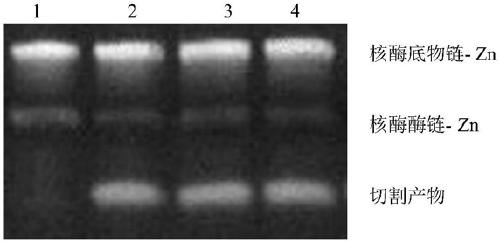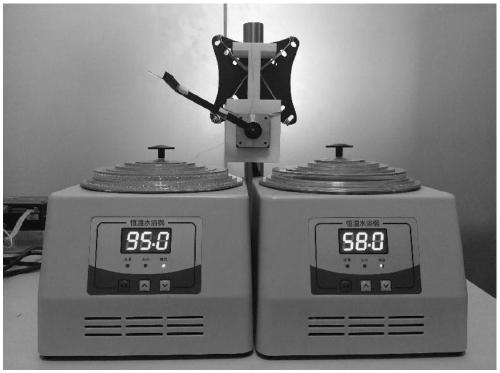Cleavage type universal-partition ultrafast-amplification visual sensor for zinc ions
A technology of zinc ions and sensors, applied in the field of biosensors, can solve the problems of long detection cycle, high price, complicated pre-treatment, etc.
- Summary
- Abstract
- Description
- Claims
- Application Information
AI Technical Summary
Problems solved by technology
Method used
Image
Examples
Embodiment 1
[0095] Example 1 The establishment of a zinc ion-cutting universal partition ultrafast amplification visualization sensor
[0096] 1. Experimental materials
[0097] SYBR Gold nucleic acid dye, nucleic acid molecular weight standard ultra-low range DNA ladder, dNTP, ExTaq DNA polymerase, 10×Taq buffer, hemin, zinc chloride, 2,2-azino-bis(3-ethyl- Benzothiazole-6-sulfonic acid) diamine salt (ABTS), H2O2, 4-hydroxyethylpiperazineethanesulfonic acid (HEPES), sodium hydroxide, disodium hydrogen phosphate, all purchased from Thermo Fisher Scientific (Thermo Scientific Life Technologies). All experimental water was from Milli-Q pure water system.
[0098] The sequence design is as follows (SEQ ID NO:1-7):
[0099]
[0100] Note: The ribozyme cuts the target product and the 3' end sequence of the amplified template is complementary;
[0101] The cleavage site is indicated by "-";
[0102] The ribozyme substrate chain-Zn and the ribozyme enzyme chain-Zn together constitute a z...
Embodiment 2
[0122] The specificity investigation of embodiment 2 sensor
[0123] According to the biosensor constructed in Example 1, 500nM Zn 2+ , 10μM Ag + , Mg 2+ , Ca 2+ 、Cd 2+ , Hg 2+ 、Cr 3+ Added to the system for detection, the results show that the established Zn 2+ The biosensor has good specificity ( Image 6 ).
Embodiment 3
[0124] Embodiment 3 standard addition experiment
[0125] Get high-purity water and detect with the biosensor constructed in embodiment 1, Zn 2+ No detection was carried out, and the standard addition experiment was carried out on it, and the results obtained by continuous measurement are shown in Table 1.
[0126] Table 1 Zn 2+ Spike recovery test results
[0127]
PUM
 Login to View More
Login to View More Abstract
Description
Claims
Application Information
 Login to View More
Login to View More - R&D
- Intellectual Property
- Life Sciences
- Materials
- Tech Scout
- Unparalleled Data Quality
- Higher Quality Content
- 60% Fewer Hallucinations
Browse by: Latest US Patents, China's latest patents, Technical Efficacy Thesaurus, Application Domain, Technology Topic, Popular Technical Reports.
© 2025 PatSnap. All rights reserved.Legal|Privacy policy|Modern Slavery Act Transparency Statement|Sitemap|About US| Contact US: help@patsnap.com



